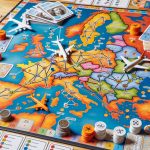Are you ready to conquer and expand your empire across the continent of Europe? In this article, we will explore the exciting world of Risk Europe board game strategy.
Whether you’re a newcomer to the game or a seasoned veteran, understanding the mechanics, rules, and strategies is crucial for achieving victory in this intense battle for supremacy. From analyzing different tactics to mastering the art of expansion and conquest, we’ll cover all aspects of gameplay to help you emerge victorious.
Risk Europe is a strategic board game that requires careful planning, cunning diplomacy, and calculated risk-taking. With its focus on conquering territories and dominating opponents, players must navigate through various challenges and scenarios to achieve their ultimate goal of dominance. Understanding the game mechanics and rules is essential for developing effective strategies that will give you an edge over your competitors.
As we delve into this comprehensive guide, we will explore the different strategies that players can employ to outwit and outmaneuver their opponents. From risk management to map-specific tactics, effective diplomacy, alliances, expanding your empire, and navigating through the role of luck in gameplay – we will provide valuable insights and tips for mastering the complexities of Risk Europe board game strategy.
So gather your armies, form your alliances, and get ready to strategize your way to victory in this thrilling game of conquest.
Understanding the Game Mechanics and Rules
Understanding the mechanics and rules of Risk Europe board game is essential for any player looking to develop effective strategies. The game is set in medieval Europe and involves players using armies to conquer territories, build castles, and achieve various objectives to earn victory points. Each player takes on the role of a noble house and aims to expand their empire across the continent while defending against rival players.
The game is played on a map of Europe divided into territories, with each territory providing resources and strategic advantages. Players take turns deploying their armies, attacking other territories, and fortifying their defenses. Understanding the specific rules for deploying armies, resolving battles, and earning victory points is crucial for developing successful strategies.
One key rule to understand is the importance of objective cards, which provide additional victory points for achieving specific goals such as controlling certain regions or building a certain number of castles. These objective cards can heavily influence a player’s strategy as they work towards fulfilling these objectives while also fending off opponents’ attacks.
Additionally, understanding the mechanics of alliances and diplomacy within the game can significantly impact a player’s success by forming temporary partnerships with other players to achieve common goals.
| Game Mechanics | Rules |
|---|---|
| Set in medieval Europe | Objective cards provide additional victory points |
| Players use armies to conquer territories | Alliances and diplomacy play a significant role |
Analyzing the Different Strategies
When it comes to the game of Risk Europe, players must have a solid understanding of the different strategies that can be employed in order to achieve victory. One key strategy is the importance of controlling key regions on the map.
By securing these areas, players can gain valuable resources and strategic advantages over their opponents. Additionally, players must also understand the balance between offense and defense, as being too aggressive can leave one vulnerable while being too defensive can slow down progress.
Another crucial aspect of strategy in Risk Europe is effective resource management. Players must carefully consider how they allocate their resources in order to build and expand their armies while also maintaining a strong defense. This involves making calculated decisions on when to attack, when to fortify defenses, and when to form alliances with other players. Understanding the value of each resource and how it impacts gameplay is essential for success in this board game.
Furthermore, players need to adapt their strategies based on their position in the game. For example, those who are falling behind may need to take more risks while those who are leading may focus on maintaining their advantage. It’s important for players to constantly assess the game state and adjust their strategies accordingly in order to increase chances of winning.
| Key Strategy Points | Description |
|---|---|
| Controlling Key Regions | Securing valuable territories for resources and strategic advantages. |
| Effective Resource Management | Allocating resources strategically for building armies, defense, and alliances. |
| Adapting Strategies Based on Position | Adjusting gameplay based on current standing in the game. |
The Importance of Risk Management in the Game
Risk management is a crucial aspect of the strategy when playing the Risk Europe board game. Without careful consideration of potential risks, players may find themselves quickly losing ground and falling behind their opponents. To effectively manage risk in the game, players must understand the different types of risks they may encounter and develop a plan to mitigate them.
Key Risks in Risk Europe Board Game Strategy:
- Losing control of key territories
- Overextending your forces
- Failing to anticipate opponent’s moves
To manage these risks, it is important for players to carefully consider their positioning on the map and analyze the potential vulnerabilities of their territories. This may involve fortifying key positions, forming alliances with other players, or strategically planning expansion routes.
Effective Risk Management Strategies:
- Prioritize defensible positions on the map
- Maintain a flexible army to respond to changing situations
- Develop contingency plans for unexpected events
By implementing these risk management strategies, players can increase their chances of success in the game and maintain a competitive edge over their opponents. As with any strategic game, Risk Europe requires foresight and adaptability in order to emerge victorious.
Key Europe Map Strategies
Controlling Key Locations
One of the key strategies in playing Risk Europe is to control key locations on the map. These locations not only provide valuable resources and bonuses, but they also serve as strategic points for launching attacks and defending territories. Key locations such as cities, ports, and trading posts can give players a significant advantage in the game. It is important to identify these locations early on and develop a plan to secure and fortify them.
Understanding Regional Bonuses
Each region on the Europe map offers different bonuses to players who control them. Understanding these regional bonuses is crucial in developing a winning strategy. Some regions may offer additional reinforcements, while others may provide discounts on building structures or recruiting units. Players should carefully consider which regions to prioritize based on their individual strategies and long-term goals.
Adapting to Changing Borders
The Europe map in Risk Europe is dynamic, with borders constantly shifting as players expand and conquer territories. A successful strategy must include the ability to adapt to changing borders and alliances. This requires flexibility and quick decision-making skills, as well as the ability to anticipate opponents’ moves. By remaining adaptable, players can capitalize on new opportunities and minimize the potential impact of losing key territories.
By employing these key Europe map strategies along with effective risk management, diplomacy, and expansion techniques, players can increase their chances of victory in Risk Europe board game strategy. Understanding the unique dynamics of the Europe map and utilizing these strategies will help players gain an advantage over their opponents and ultimately emerge victorious in this challenging game of conquest.
Tips for Effective Diplomacy and Alliances
Mastering the art of diplomacy and forming strategic alliances is a crucial aspect of playing Risk Europe board game. In this section, we will explore some tips for effective diplomacy and forming alliances that can give players an edge in the game.
Understanding the Dynamics of Diplomacy
One of the key aspects of effective diplomacy in Risk Europe board game is understanding the dynamics of negotiation and communication with other players. It is important to gauge the intentions and strategies of your opponents while also convincing them to align with your own objectives. Developing diplomatic skills such as persuasion, negotiation, and compromise can greatly enhance a player’s ability to form alliances and influence other players.
Building Trust and Alliances
Building trust among other players is essential for successful alliances in Risk Europe. Players should focus on demonstrating loyalty, keeping promises, and showing reliability in order to build strong alliances. Additionally, identifying common goals with potential allies and offering mutual benefits can help facilitate the formation of strategic partnerships.
Effective Communication
Clear and effective communication is vital when it comes to diplomacy and forming alliances in Risk Europe board game. Players should be able to articulate their objectives convincingly and be transparent about their intentions. Furthermore, maintaining an open line of communication with allies throughout the game can help coordinate moves, share valuable information, and react swiftly to changing circumstances on the map.
By employing these tips for effective diplomacy and alliance-building, players can increase their chances of success in Risk Europe board game by gaining valuable support from allies on the battlefield. Of course, there are always risks involved when collaborating with others, so it’s important for players to carefully weigh the potential benefits against the
Common Mistakes and How to Avoid Them
When playing Risk Europe, it’s important to be aware of the common mistakes that players often make so that you can avoid falling into the same traps. Here are some of the most frequent errors and how you can steer clear of them:
1. Overextending your forces: One of the biggest mistakes in Risk Europe is overextending your armies, trying to conquer too much territory too quickly. This can leave your borders vulnerable and open you up to attacks from other players. Instead, focus on strategic expansion and consolidating your positions before making further advances.
2. Ignoring diplomacy and alliances: Another common mistake is neglecting the importance of diplomacy and alliances in the game. Forming alliances with other players can provide valuable support and protection, while neglecting diplomacy can leave you isolated and vulnerable to coordinated attacks.
3. Underestimating the role of luck: While strategy plays a major role in Risk Europe, luck also has an impact on the game due to dice rolls. It’s a mistake to rely too heavily on luck or underestimate its influence on the outcome of battles. Instead, focus on developing solid strategies that can withstand both good and bad luck.
By being aware of these common mistakes and actively working to avoid them, you can improve your chances of success in Risk Europe. Remember to focus on strategic expansion, prioritize diplomacy and alliances, and always have a contingency plan for dealing with both good and bad luck during the game.
Mastering the Art of Expansion and Conquest
Expanding and conquering territories is a crucial aspect of achieving victory in the Risk Europe board game. As players aim to dominate and control different regions, mastering the art of expansion and conquest becomes essential for success. This section will delve into strategies and tips for effectively expanding your empire and conquering territories to strengthen your position in the game.
One key strategy for expansion and conquest in Risk Europe is to focus on controlling strategic regions. These include areas with valuable resources or those that provide advantageous positioning on the map. By prioritizing these regions, players can establish a strong foothold in key areas, making it easier to expand their influence and launch successful conquests.
Another important aspect of expansion and conquest in Risk Europe is the careful consideration of neighboring territories. It is crucial to assess the risk versus reward of attempting to conquer adjacent regions, as this can impact your overall position in the game. Understanding the strengths and weaknesses of both your own forces and those of your opponents is essential for making calculated decisions when expanding and conquering territories.
Additionally, leveraging alliances and diplomacy can play a significant role in successful expansion and conquest. Forming temporary alliances with other players to jointly conquer or defend territories can provide a strategic advantage.
However, it’s important to remain vigilant and not rely too heavily on alliances, as they can quickly shift or dissolve as the game progresses. By considering these strategies for expansion and conquest, players can enhance their chances of victory in Risk Europe while navigating the inherent risks involved in strategic gameplay.
The Role of Luck in Risk Europe Board Game Strategy
When it comes to playing Risk Europe board game strategy, understanding the role of luck is crucial. Luck plays a significant part in the outcome of the game, as it can heavily influence battles, card draws, and dice rolls. While strategy and skill are important factors in determining success in the game, luck also plays a pivotal role in shaping the overall outcome.
In Risk Europe, luck can manifest in various ways. From the initial placement of armies to acquiring territories through dice rolls, luck can have both positive and negative impacts on a player’s position in the game.
For example, a lucky dice roll can result in successful conquests and expansion, while an unlucky turn of events can lead to lost battles and setbacks. Understanding how luck can affect gameplay is essential for developing a well-rounded strategy that accounts for unexpected outcomes.
While luck can sway the tide of battle, players should not solely rely on chance when formulating their strategy. Instead, they should focus on maximizing their opportunities by making calculated decisions based on risk assessment and strategic planning. By acknowledging the role of luck and incorporating it into their overall strategy, players will be better prepared to adapt to unpredictable outcomes and increase their chances of achieving victory through effective risk management.
Ultimately, mastering Risk Europe board game strategy involves finding the right balance between skillful planning and adapting to unforeseen circumstances influenced by luck. By understanding the impact of luck on gameplay and incorporating it into their strategic approach, players can enhance their overall performance and increase their likelihood of conquering Europe in this exciting board game experience.
Conclusion
In conclusion, mastering the art of Risk Europe board game strategy involves a combination of understanding the game mechanics and rules, analyzing different strategies, and effectively managing risk. The game provides players with the opportunity to exercise their strategic thinking, diplomacy, and negotiation skills while navigating the complexities of conquest and expansion on the European map.
One of the key factors in achieving victory in Risk Europe is the ability to assess and manage risk effectively. Making calculated decisions based on a thorough understanding of the game’s mechanics and rules can significantly impact a player’s success. Whether it’s choosing the right alliances, using diplomatic tactics, or avoiding common mistakes, strategic risk management plays a crucial role in determining the outcome of the game.
Furthermore, luck does play a role in Risk Europe board game strategy, but it is not the sole determinant of victory. By combining careful planning with adaptability and flexibility, players can increase their chances of success.
Ultimately, bringing together all aspects of strategy discussed in this article – from understanding map strategies to mastering expansion and conquest – will provide players with a comprehensive approach to achieving victory in Risk Europe. With dedication, practice, and effective decision-making skills, players can enhance their gameplay and improve their chances of emerging triumphant in this challenging yet rewarding board game experience.
Frequently Asked Questions
What Is the Best Strategy for the Game Risk?
The best strategy for the game Risk involves a combination of aggression and caution. It’s important to expand your territory while also protecting your borders. Balancing offense and defense is key.
What Is the Best Country to Start in Risk?
The best country to start in Risk depends on the player’s personal style and strategy. Generally, countries with fewer borders and potential for expansion are good choices, such as Australia or South America.
What Is the Best Continent to Conquer in Risk?
The best continent to conquer in Risk also varies based on individual play style. However, Australia is often considered one of the best continents to conquer due to its limited access points, making it easier to defend once captured.

I love playing all kinds of games – from classics like Monopoly to modern favourites like Ticket to Ride.
I created this blog as a way to share my love of board games with others, and provide information on the latest releases and news in the industry.





